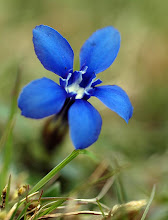These are the radiating gills of the toadstool known as weeping widow Lacrymaria velutina. For more about this toadstool, visit http://cabinetofcuriosities-greenfingers.blogspot.com/2009/10/weeping-widow.html
The surface layer of the gills, known as the hymenium, produces thousands of spores, and for these to be successfully released into the airstream the gills must always be vertically aligned, so they are very sensitive to the force of gravity and quickly realign themselves if the stipe of the toadstool bends away from the vertical and tilts the cap.
Here, at a microscope magnification of x40 you can see the spores lining the surface of the gills....
...and here, at a magnification of x100 you can see that each is shaped like a small brownish-black lemon..
The spores are formed in groups of 4 on a cell called a basidium, attached to it by short stalks, seen here at a magnification of x400 under the microscope....

... and these appear to be two basidia where the spores are beginning to form. When they're mature and drop off they'll fall vertically down the gaps between those parallel, perfectly vertical gills and will be wafted away in the airstream
If you cut off a toadstool cap, turn it gill side down on a piece of paper of contrasting colour to the spores and leave it in a warm room where there are no draughts for a couple of hours, the falling spores will produce a beautiful spore print.....
...like this





















I didn't know that the gills adjusted to stay vertical. Always something new to learn here Phil. Thanks.
ReplyDeleteMorning John, yes, it's quite a quick process in toadstools with gills, but slow in the ones with pores where it's more difficult for them to adjust their growth ... I wonder if this may be why toadstools with pores instead of gills have stouter stems or are brackets fixed to trees - their caps are less likely to be tilted.
ReplyDeleteReally beautiful. I would like to see some pictures of Tremella or a genus like that.
ReplyDeleteGreat post! A nicely done pore print is a real work of art.
ReplyDeletecheers,
Wilma
Hi Greenneko, thanks for visiting ... will try to find some Tremella for a future visit..
ReplyDeleteThanks Wilma, I usually fix the spore prints with artists' spray varnish but they're never quite as good after that ..... I've been advised by a colleague that the best way to preserve them is on waxed paper, that's then gently warmed to make the spores stick
ReplyDelete